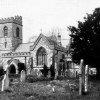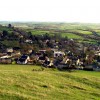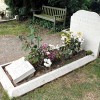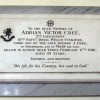Puddletown: small town or large village? The name suggests the former and in earlier times there is no doubting it deserved the rank. Nowadays, with the decline of services and facilities common to all rural areas its role has diminished to a dormitory for Dorchester. The designation large village is more appropriate for a parish of some 7,185 acres.
Puddletown attracted people from the surrounding villages and hamlets and was the commercial hub for this rural and under developed part of Dorset. Only about half of the nearly 1400 inhabitants recorded in the census of 1851 were born there. The town had permission, granted before the reformation, to hold two fairs each year and to hold weekly markets. There was employment for all kinds of craftsmen and tradesmen.
In addition to the several shopkeepers there were three bakers, a couple of butchers, a grocer and a post office complemented by two inns, two pubs or alehouses, six cordwainers (boot and shoe makers), three stonemasons, a cabinet maker, three blacksmiths, a saddler and harness maker, two tailors and two dressmakers, all doing business in the town. Puddletown also had a surgeon and a dentist and the town employed two school mistresses.
The parish church is near the centre of the village. St.Mary’s is a church that has escaped being mucked about by our Victorian ancestors but since the 12th century it has enjoyed its fair share of restoration works. There was a church here in Saxon times but the oldest part of St. Mary’s visible today is a section of the tower, probably no older than the late 12th century. Transepts added in the 13th century, turned the earlier structure cruciform in plan.
Most of the building we see today date from around the beginning of the 15th century when the glorious oak roof was put up. A century later more restoration work saw the roof being raised, the addition of a clerestory, a north aisle, the tower heightened by 20ft with an external staircase built on and the parapet on the tower was added at the same time. The tower’s bell chamber is home to six bells one dating from 1599.
In 1634 the people of Puddletown were to agree to fit out the church with much of the interior furniture and fittings we see here today. New seating, a new pulpit and prayer desk, communion table and rails as well as a new font cover were commissioned. The texts on the walls are from this period.
The unusual tumbler shaped font is from the 12th century decorated with a repeating pattern of acanthus leaves; the octagonal pyramid shaped cover is from 1635. From the same period the magnificent three stage pulpit with tester, the box pews and, the most ambitious addition from this time, the west gallery.
Difficult to believe now but the chancel was a tiny space till restoration works paid for by Revd. J.C. Brymer and completed in 1911. Nowadays, the east end of the nave, the carpeted chancel and the north east chapel make a wide open spaced area contrasting with the nave proper resulting in that appearing a little cluttered by the box pews that are, nevertheless, delightful. The nave has a north arcade of four bays and there is a wide north aisle. There is a south chapel containing tombs from the 13th to 16th centuries, and a south vestry.
By the end of the 19th century the population of Puddletown had fallen by about a third but now, no doubt because of its convenience for the county town, the number of inhabitants is back up to levels not seen for nearly two hundred years.



